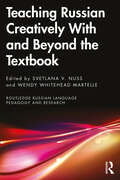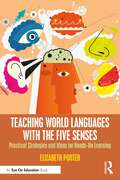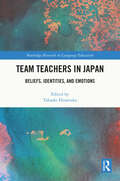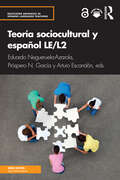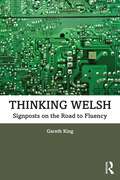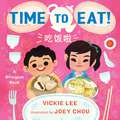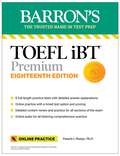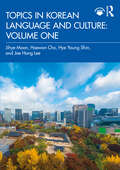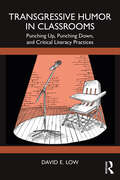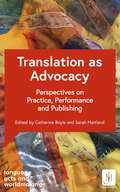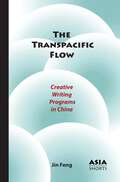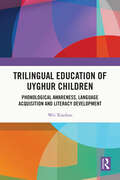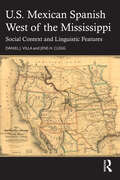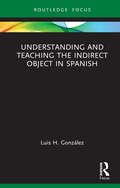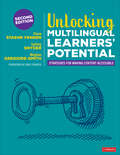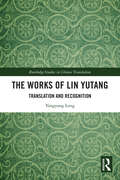- Table View
- List View
Teaching Russian Creatively With and Beyond the Textbook (Routledge Russian Language Pedagogy and Research)
by Svetlana V. Nuss Wendy Whitehead MartelleTeaching Russian Creatively With and Beyond the Textbook is a collection of pedagogical narratives that promotes impactful approaches to teaching Russian as a Foreign Language (RFL) when supplementing or going beyond a specific textbook. With the lightning pace of modern news, social media, and technology, textbooks quickly become outdated and as a response to these rapid changes, this edited volume showcases a wide range of approaches to teaching RFL with and beyond traditional textbooks. The reader will find many creative ideas and solid practical advice from colleagues who have experimented with task- based language teaching, corpus-based learning, drama-based pedagogy, community-engaged pedagogy, and technology-mediated language learning, while incorporating authentic materials and turning them into living textbooks.The book will be a useful resource for Russian instructors and language departments interested in engaging their students with creative and unique courses.
Teaching World Languages with the Five Senses: Practical Strategies and Ideas for Hands-On Learning
by Elizabeth PorterWith this fun, practical guide, you will have everything you need to re-envision and reinvigorate your world language classroom. Author Elizabeth Porter draws on a brain-based approach to show how language learning is a sensory experience. Students can effectively learn languages and improve retention through activities and lessons that incorporate the five senses – sight, hearing, taste, touch, and smell. Chapters include real-world, research-backed examples and classroom strategies and activities ready for use. An essential resource for world language teachers, this book introduces language learning philosophy and an out-of-the-box, effective approach that uses neuroscience combined with best practices to promote a highly engaging language learning environment.
Teaching World Languages with the Five Senses: Practical Strategies and Ideas for Hands-On Learning
by Elizabeth PorterWith this fun, practical guide, you will have everything you need to re-envision and reinvigorate your world language classroom. Author Elizabeth Porter draws on a brain-based approach to show how language learning is a sensory experience. Students can effectively learn languages and improve retention through activities and lessons that incorporate the five senses – sight, hearing, taste, touch, and smell. Chapters include real-world, research-backed examples and classroom strategies and activities ready for use. An essential resource for world language teachers, this book introduces language learning philosophy and an out-of-the-box, effective approach that uses neuroscience combined with best practices to promote a highly engaging language learning environment.
Team Teachers in Japan: Beliefs, Identities, and Emotions (Routledge Research in Language Education)
by Takaaki HiratsukaThis book provides insights into the professional and personal lives of local language teachers and foreign language teachers who conduct team-taught lessons together. It does this by using the Japanese context as an illustrative example. It re-explores in this context the professional experiences and personal positionings of Japanese teachers of English (JTEs) and foreign assistant language teachers (ALTs), as well as their team-teaching practices in Japan. This edited book is innovative in that 14 original empirical studies offer a comprehensive overview of the day-to-day professional experiences and realities of these team teachers in Japan, with its focus on their cognitive, ideological, and affective components. This is a multifaceted exploration into team teachers in their gestalt—who they are to themselves and in relation to their students, colleagues, community members, and crucially to their teaching partners. This book therefore offers several empirical and practical applications for future endeavors involving team teachers and those who engage with them—including their key stakeholders, such as researchers on them, their teacher educators, local boards of education, governments, and language learners from around the world.
Teoría sociocultural y español LE/L2 (Routledge Advances in Spanish Language Teaching)
by Eduardo Negueruela-Azarola Próspero N. García Arturo EscandónTeoría sociocultural y español LE/L2 es una introducción académica a conceptos clave de la teoría sociocultural aplicada a la enseñanza y el aprendizaje de español como segunda lengua y lengua extranjera. Los capítulos han sido escritos por expertos de todo el mundo, tanto por investigadores y profesores de larga trayectoria como por nuevos investigadores. La obra ofrece una revisión detallada del impacto de las ideas socioculturales en la enseñanza y aprendizaje de español. Es el primer libro que se publica en español con este enfoque. En sus páginas se documenta la transformación que el enfoque sociocultural está produciendo en la enseñanza-aprendizaje de segundas lenguas, en su investigación y evaluación, y en la formación docente. La obra concibe el aprendizaje y el desarrollo como actividades socioculturales e interpersonales, y destaca el objetivo de la evaluación y de la investigación como herramientas de intervención dinámica para el aprendizaje y crecimiento y, finalmente, cómo un enfoque sociocultural ilumina la importancia de la mediación en los procesos de aprendizaje y desarrollo de la persona. El volumen tiene las siguientes características: Incluye una entrevista con James P. Lantolf, uno de los investigadores más prominentes de la teoría sociocultural aplicada a las segundas lenguas. Un uso consistente de la terminología de la teoría sociocultural en español a lo largo de toda la obra. Cada capítulo tiene una estructura homogénea, lo cual facilita su consulta. No reproduce la literatura existente en inglés, sino que desarrolla propuestas teóricas y de investigación propias y novedosas. Incluye un glosario, disponible en línea, de términos relevantes en la teoría sociocultural con breves definiciones. Diseñado y pensado para aquellos sin conocimientos previos de la teoría, Teoría sociocultural y español LE/L2 ofrece explicaciones claras y accesibles sobre la TSC acompañadas de ejemplos concretos y aplicaciones prácticas para la clase de lenguas. Es un recurso esencial para cualquiera que enseñe español LE/L2, así como para quienes investiguen su adquisición. Teoría sociocultural y español LE/L2 introduces the key concepts of sociocultural theory (SCT) as they apply to the teaching and acquisition of Spanish as a second and foreign language. Contributions from leading experts from across the globe, both well-established and emerging scholars, offer an in-depth view of how a sociocultural approach can impact the teaching and learning of Spanish. The first book on this subject to be written in Spanish, this unique volume examines the transformation that sociocultural ideas are producing and conceives learning and development as sociocultural and interpersonal activities. It highlights the objective of evaluation and research as dynamic intervention tools for learning and growth, the active role learners must play, and how a sociocultural approach illuminates the importance of mediation in the learning and development processes of the individual. Key features include: An interview with James P. Lantolf, one of the most prominent researchers in SCT applied to second languages A consistent use of sociocultural theory terminology in Spanish throughout A homogeneous chapter structure which makes it easy to consult Its own newly developed theoretical and research proposals An online glossary of relevant terms in sociocultural theory with brief definitions. Designed for those with no prior knowledge of the subject area, Teoría sociocultural y español LE/L2 provides straightforward and accessible explanations of SCT accompanied by specific and practical applications for the language classroo
Teoría sociocultural y español LE/L2 (Routledge Advances in Spanish Language Teaching)
by Eduardo Negueruela-Azarola Próspero N. García Arturo EscandónTeoría sociocultural y español LE/L2 es una introducción académica a conceptos clave de la teoría sociocultural aplicada a la enseñanza y el aprendizaje de español como segunda lengua y lengua extranjera. Los capítulos han sido escritos por expertos de todo el mundo, tanto por investigadores y profesores de larga trayectoria como por nuevos investigadores. La obra ofrece una revisión detallada del impacto de las ideas socioculturales en la enseñanza y aprendizaje de español.Es el primer libro que se publica en español con este enfoque. En sus páginas se documenta la transformación que el enfoque sociocultural está produciendo en la enseñanza-aprendizaje de segundas lenguas, en su investigación y evaluación, y en la formación docente. La obra concibe el aprendizaje y el desarrollo como actividades socioculturales e interpersonales, y destaca el objetivo de la evaluación y de la investigación como herramientas de intervención dinámica para el aprendizaje y crecimiento y, finalmente, cómo un enfoque sociocultural ilumina la importancia de la mediación en los procesos de aprendizaje y desarrollo de la persona.El volumen tiene las siguientes características: Incluye una entrevista con James P. Lantolf, uno de los investigadores más prominentes de la teoría sociocultural aplicada a las segundas lenguas Un uso consistente de la terminología de la teoría sociocultural en español a lo largo de toda la obra Cada capítulo tiene una estructura homogénea, lo cual facilita su consulta No reproduce la literatura existente en inglés, sino que desarrolla propuestas teóricas y de investigación propias y novedosas Incluye un glosario, disponible en línea, de términos relevantes en la teoría sociocultural con breves definiciones Diseñado y pensado para aquellos sin conocimientos previos de la teoría, Teoría sociocultural y español LE/L2 ofrece explicaciones claras y accesibles sobre la TSC acompañadas de ejemplos concretos y aplicaciones prácticas para la clase de lenguas. Es un recurso esencial para cualquiera que enseñe español LE/L2, así como para quienes investiguen su adquisición.Chapter 4 of this book is freely available as a downloadable Open Access PDF at http://www.taylorfrancis.com under a Creative Commons Attribution-Non Commercial-No Derivatives (CC-BY-NC-ND) 4.0 license.Teoría sociocultural y español LE/L2 introduces the key concepts of sociocultural theory (SCT) as they apply to the teaching and acquisition of Spanish as a second and foreign language. Contributions from leading experts from across the globe, both well-established and emerging scholars, offer an in-depth view of how a sociocultural approach can impact the teaching and learning of Spanish.The first book on this subject to be written in Spanish, this unique volume examines the transformation that sociocultural ideas are producing and conceives learning and development as sociocultural and interpersonal activities. It highlights the objective of evaluation and research as dynamic intervention tools for learning and growth, the active role learners must play, and how a sociocultural approach illuminates the importance of mediation in the learning and development processes of the individual.Key features include: An interview with James P. Lantolf, one of the most prominent researchers in SCT applied to second languages A consistent use of sociocultural theory terminology in Spanish throughout A homogeneous chapter structure which makes it easy to consult Its own newly developed theoretical and research proposals An online glossary of relevant terms in sociocultural theory with brief definitions Designed for those with no prior knowledge of the subject area, Teoría sociocultural y español LE/L2 provides straightforward and accessible explanations of SCT accompanied by specific and practical applications for the language classroom. It is an essential resource for anyone
Thinking Welsh: Signposts on the Road to Fluency
by Gareth KingThinking Welsh focuses on how common English words, phrases and constructions map onto Welsh, and highlights the key areas of difference and difficulty in these mapping operations. 150 English words and grammatical and communicative concepts are listed alphabetically, explained in clear and accessible language, and given ample exemplification to illustrate their meaning and use. All instances of mutation are marked with the usual typographic signs, and cross-references are given throughout to related entries. A list of essential grammatical terms and a Welsh index round off the manual. Thinking Welsh is a ground-breaking resource for post-beginner students wishing to explore lexical issues and master key syntactic structures as a way of attaining fluency of expression and comprehension in modern spoken and standard Welsh.
Time to Eat!
by Vickie LeeSparse text and bright illustrations help readers learn the names of all of their favorite dishes in both English and Mandarin. From spare ribs to spring pea shoots there's something for everyone in this timeless story about dinner time.
TOEFL iBT Premium with 8 Online Practice Tests + Online Audio, Eighteenth Edition (Barron's Test Prep)
by Pamela J. Sharpe Ph.D.Barron&’s newest edition of TOEFL iBT has been fully updated to reflect the new TOEFL format and provides flexible study options and key skills review to help you study what you need to know for the test. This edition includes: 8 full-length TOEFL iBT practice tests that reflect the most recent test format with answer explanations Comprehensive review of required academic and language skills Four video lessons on the key skills needed to succeed on the TOEFL: Note Taking, Paraphrasing, Summarizing, and Synthesis Grammar review that supports the Speaking and Writing Sections Online audio for all listening prompts
Topics in Korean Language and Culture: Volume One
by Jihye Moon Haewon Cho Hye Young Shin Jae Hong LeeTopics in Korean Language and Culture: Volume One covers 12 essential topics relating to both traditional and contemporary Korean culture and society.Each chapter consists of listening and reading passages, key expressions and grammar, and performance-based activities unfolding across different modes of oral and written communication. The grammar section is organized into foundation review, semantic distinction, and language function to help learners advance beyond the plateau of intermediate proficiency. All passages are carefully written to resemble authentic texts used by Korean native speakers and to include various text types and speech styles that learners will encounter in real life.The first volume specifically targets students in their third year of learning Korean. It is designed to accommodate a wide range of courses and curricula existing for Korean programs today. It is intended for a yearlong language sequence as well as an intensive topic course in speaking, reading, or writing.
Transgressive Humor in Classrooms: Punching Up, Punching Down, and Critical Literacy Practices
by David E. LowIn this innovative book, David E. Low examines the multifaceted role of humor in critical literacy studies. Talking about how teachers and students negotiate understandings of humor and social critique vis-à-vis school-based critical literacy curriculums, the book co-examines teachers’ and students’ understandings of humor and critique in schools.Critical literacy centers discussions on power and social roles but often overlooks how students use transgressive humor as a means to interrogate power. Through examples of classroom interactions and anecdotes, Low analyzes the role of humor in classroom settings to uncover how humor interplays with critical inquiry, sensemaking, and nonsense-making. Articulated across the fields of literacy studies and humor studies, the book uses ethnographic data from three Central California high schools to establish linkages and dissonances between critical literacy education and adolescents’ joking practices. Adopting the dialectic of punching up and punching down as a conceptual framework, the book argues that developing more nuanced understandings of transgressive humor presents educators with opportunities to cultivate deeper critical literacy pedagogies and that doing so is a matter of social justice.Essential for scholars and students in literacy education, this book adds to the scholarship on critical literacy by exploring the subversive power of humor in the classroom.
Translation as Advocacy: Perspectives on Practice, Performance and Publishing (Language Acts and Worldmaking)
by VariousWhat does it mean to advocate - in translation, for translation, through translation? What does advocacy look like, for those who do the translating or for those whose work is translated? To what extent is translation itself a form of advocacy? These 'what' questions are the driving force behind this collection.Translation as Advocacy highlights the innovative ways in which translator-academics in seven different fields discuss their practice in relation to their understanding of advocacy. The book aims to encourage people to think about translators as active agents bringing new work into the receiving culture, advocating for the writers they translate, for ideas, for practices. As such, the book asserts that the act of translation is a mode of cultural production and a political intervention through which the translator, as advocate, claims a significant position in intercultural dialogue.Featuring seven interrelated chapters, the book covers themes of judgement, spaces for translation, classroom practice, collaboration, intercultural position, textuality, and voice. Each chapter explores the specific demands of different types of translation work, the specific role of each stage of the process and what advocacy means at each of these stages, for example: choosing what is translated; mediating between author and receiving culture; pitching to publishers; social interactions; framing the translation for different audiences; teaching; creating new canons; gatekeepers and prizes; dissemination; marketing and reception. This book repositions the role of the translator-academic as an activist who uses their knowledge and understanding to bring agency to the complex processes of understanding across time and space. Moving critically through the different stages that the translator-academic occupies, using the spaces for research, performance and classroom teaching as springboards for active engagement with the key preoccupations of our times, this book will highlight translation as advocacy for students, educators, audiences for translation and the translation industry.Like all the volumes in the Language Acts and Worldmaking series, the overall aim is two-fold: to challenge widely-held views about language learning as a neutral instrument of globalisation and to innovate and transform language research, teaching and learning, together with Modern Languages as an academic discipline, by foregrounding its unique form of cognition and critical engagement.Specific aims are to:· propose new ways of bridging the gaps between those who teach and research languages and those who learn and use them in everyday contexts from the professional to the personal· put research into the hands of wider audiences· share a philosophy, policy and practice of language teaching and learning which turns research into action· provide the research, experience and data to enable informed debates on current issues and attitudes in language learning, teaching and research· share knowledge across and within all levels and experiences of language learning and teaching· showcase exciting new work that derives from different types of community activity and is of practical relevance to its audiences· disseminate new research in languages that engages with diverse communities of language practitioners.
Translation as Advocacy: Perspectives on Practice, Performance and Publishing (Language Acts and Worldmaking)
by VariousWhat does it mean to advocate - in translation, for translation, through translation? What does advocacy look like, for those who do the translating or for those whose work is translated? To what extent is translation itself a form of advocacy? These 'what' questions are the driving force behind this collection.Translation as Advocacy highlights the innovative ways in which translator-academics in seven different fields discuss their practice in relation to their understanding of advocacy. The book aims to encourage people to think about translators as active agents bringing new work into the receiving culture, advocating for the writers they translate, for ideas, for practices. As such, the book asserts that the act of translation is a mode of cultural production and a political intervention through which the translator, as advocate, claims a significant position in intercultural dialogue.Featuring seven interrelated chapters, the book covers themes of judgement, spaces for translation, classroom practice, collaboration, intercultural position, textuality, and voice. Each chapter explores the specific demands of different types of translation work, the specific role of each stage of the process and what advocacy means at each of these stages, for example: choosing what is translated; mediating between author and receiving culture; pitching to publishers; social interactions; framing the translation for different audiences; teaching; creating new canons; gatekeepers and prizes; dissemination; marketing and reception. This book repositions the role of the translator-academic as an activist who uses their knowledge and understanding to bring agency to the complex processes of understanding across time and space. Moving critically through the different stages that the translator-academic occupies, using the spaces for research, performance and classroom teaching as springboards for active engagement with the key preoccupations of our times, this book will highlight translation as advocacy for students, educators, audiences for translation and the translation industry.Like all the volumes in the Language Acts and Worldmaking series, the overall aim is two-fold: to challenge widely-held views about language learning as a neutral instrument of globalisation and to innovate and transform language research, teaching and learning, together with Modern Languages as an academic discipline, by foregrounding its unique form of cognition and critical engagement.Specific aims are to:· propose new ways of bridging the gaps between those who teach and research languages and those who learn and use them in everyday contexts from the professional to the personal· put research into the hands of wider audiences· share a philosophy, policy and practice of language teaching and learning which turns research into action· provide the research, experience and data to enable informed debates on current issues and attitudes in language learning, teaching and research· share knowledge across and within all levels and experiences of language learning and teaching· showcase exciting new work that derives from different types of community activity and is of practical relevance to its audiences· disseminate new research in languages that engages with diverse communities of language practitioners.
The Transpacific Flow: Creative Writing Programs in China (Asia Shorts)
by Jin FengWhat happens when a US cultural institution is imported to China, the purported chief rival of the United States in the twenty-first century? The first book-length account of university-based creative writing programs in China, this book reveals how Chinese intellectuals adapt American-style writing programs such as the Iowa Writers’ Workshop and the International Writing Program at Chinese universities to seek agency and literary innovation in the last two decades. The rise of creative writing programs in China explains broader issues of cultural production in an increasingly authoritarian and market-oriented postsocialist state. By telling a unique story of Chinese intellectuals’ interactions with an influential Western cultural institution, this book also shows how varied cultural and geopolitical priorities can rewrite the story of the global influence of the United States.
Trilingual Education of Uyghur Children: Phonological Awareness, Language Acquisition and Literacy Development
by Wei XiaobaoGiven the differences in the orthographic structure of the Uyghur, Chinese and English languages, this study used a mixed-method approach to systematically describe and analyze the phonological awareness of Uyghur bilingual children as English learners and its contributions to their trilingual literacy acquisition and development.Focusing on the development of these learners' phonological awareness in Uyghur, Chinese and English, this study explored the influences of Uyghur and Chinese learning on the formation of their English phonological awareness and the roles of different components of phonological awareness in their trilingual literacy development. Based on the characteristics of the phonetic structure in Uyghur, Chinese and English and the development of Uyghur children's phonological awareness in these languages, a Chinese phonetic identification training and Uyghur–Chinese–English comprehensive phonetic training program (including intensive phoneme category contrast training and phonics training) was designed to explore whether such targeted phonetic identification training can effectively improve these children's phonological awareness in Chinese and English and thus further promote their trilingual literacy development.This book will appeal to researchers and students interested in the fields of psycholinguistics, language acquisition and multilingual education.
U.S. Mexican Spanish West of the Mississippi: Social Context and Linguistic Features
by Daniel J. Villa Jens H. CleggU.S. Mexican Spanish West of the Mississippi proposes a macro-dialect of the most widely spoken Spanish variety in the western United States from a number of social and linguistic angles. This book is unique in its focus on this one variety of Spanish, which allows for a closer investigation of the social context and linguistic features through a number of different topics. Comprised of 13 chapters divided into two sections, this textbook provides insight into the history, demographics, migration, and social issues of US Mexican Spanish in the first section and its lexicography, phonology, and structure in the second. Useful for scholars interested in Spanish in the United States, dialectology, and sociolinguistics, this is also an ideal resource for advanced undergraduate and graduate students of Spanish.
Understanding and Teaching the Indirect Object in Spanish (Verber, Verbed Grammar)
by Luis H. GonzálezUnderstanding and Teaching the Indirect Object in Spanish presents an easy-to-understand approach to all aspects of direct and indirect objects in Spanish. Distinguishing between direct and indirect objects can pose challenges for learners and is almost impossible to do using the tools that linguists have traditionally used. This book offers two simple, all-encompassing inferences that allow learners to tackle this area of language by intuitively inferring the distinction, as native speakers do, between verber and verbed. This book will be of interest to teachers and learners of Spanish and other second languages, as well as linguists interested in argument structure, second language acquisition, second language teaching or pedagogy, and multilingualism.
Unlocking Multilingual Learners’ Potential: Strategies for Making Content Accessible
by Diane Staehr Fenner Sydney Cail Snyder Meghan Gregoire-SmithBring classroom content to life for multilingual learners In this eagerly anticipated revision of their bestselling book, authors Diane Staehr Fenner, Sydney Snyder, and Meghan Gregoire-Smith share dynamic, research-backed strategies that every educator of multilingual learners (MLs) can add to their repertoire. Including more of what educators loved from the first edition—authentic classroom examples, a wide variety of research-based instructional strategies, and practical tools to implement across grade levels and content areas—this is the ultimate practical guide to unlocking the potential of MLs in K-12 classrooms. With fresh graphics and eye-catching colors, this thoroughly revised edition also includes: Considerations for newcomers and students with interrupted or no formal education (SLIFE) An added chapter on building scaffolded instruction and peer learning opportunities into MLs’ academic reading and writing activities Additional opportunities for reflection and application A new unit planning template aligned with research-based instructional practices, including a completed example unit Situated within five core beliefs that frame the must-haves for MLs’ equitable and excellent education, Unlocking Multilingual Learners′ Potential is a guide to research-based practices and a toolbox of strategies every educator can implement to make content accessible and increase language proficiency among MLs.
Unlocking Multilingual Learners’ Potential: Strategies for Making Content Accessible
by Diane Staehr Fenner Sydney Cail Snyder Meghan Gregoire-SmithBring classroom content to life for multilingual learners In this eagerly anticipated revision of their bestselling book, authors Diane Staehr Fenner, Sydney Snyder, and Meghan Gregoire-Smith share dynamic, research-backed strategies that every educator of multilingual learners (MLs) can add to their repertoire. Including more of what educators loved from the first edition—authentic classroom examples, a wide variety of research-based instructional strategies, and practical tools to implement across grade levels and content areas—this is the ultimate practical guide to unlocking the potential of MLs in K-12 classrooms. With fresh graphics and eye-catching colors, this thoroughly revised edition also includes: Considerations for newcomers and students with interrupted or no formal education (SLIFE) An added chapter on building scaffolded instruction and peer learning opportunities into MLs’ academic reading and writing activities Additional opportunities for reflection and application A new unit planning template aligned with research-based instructional practices, including a completed example unit Situated within five core beliefs that frame the must-haves for MLs’ equitable and excellent education, Unlocking Multilingual Learners′ Potential is a guide to research-based practices and a toolbox of strategies every educator can implement to make content accessible and increase language proficiency among MLs.
The Works of Lin Yutang: Translation and Recognition (Routledge Studies in Chinese Translation)
by Yangyang LongThe Works of Lin Yutang is the first book to provide a comprehensive study of Lin Yutang’s translation theory and translated (and written) works in English as a whole, examined from the perspective of his pursuit of recognition of cultural equity between China and the English-speaking world. The arc of the book is Lin’s new method of translating China to the Anglophone world, which is crucial to rendering Chinese culture as an equal member of the modern world. This book identifies Lin’s legacy of translation and recognition as his acknowledgement of source and target cultural territories in translation, and at the same time, his questioning of perspectives that privilege the authority of either. This book will appeal to scholars and students in Translation Studies, World and Comparative Literature, Literary and Cultural Studies, and Chinese Studies. It can also be used as a reference work for practitioners in translation and creative writing.
